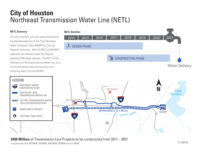 Underground Solutions Inc. Fusion operators were under pressure to get the pipe moving again. |
Taking a chance on an innovative method for installing a mile-long force main appears to have paid off for a South Carolina water utility. The contractor used horizontal directional drilling to bore a way for more than 5,000 ft of butt-fused pipe, then pulled the 10-in.-diameter pipe back through the borehole. The pullback is the longest ever for the novel gasketless PVC.
The project will deliver up to 1 million gallons per day of reuse water from the Port Royal Water Reclamation Facility, operated by the Beaufort Jasper Water & Sewer Authority, Beaufort, S.C., to irrigate Secession Golf Course across the Beaufort River. The $1.7-million project, 18 months in the planning, mobilized on May 19 and began horizontal directional drilling under the river. It climaxed June 11 with a successful, 17-hour operation to pull 5,120 ft of PVC pipe back through, with the pullback suspended four times for as long as two hours to fuse 1,000-ft strings of pipe before continuing.
Mears Group, Rosebush, Mich., bored the tunnel under a $900,000 risk-sharing general contract. The owner contracted directly with Underground Solutions Inc., Poway, Calif., for $170,000 to furnish and install its proprietary fusible PVC pipe.
 Underground Solutions Inc. Hanger rollers feed fused PVC into the ground for continuous operation. |
The pipe is unique in the market, says Curt Askeland, project manager for consulting engineer Hussey, Gay, Bell & DeYoung, Savannah, Ga., which designed the project. The original design called for HDPE pipe inside a steel casing, but "that came in over budget," he says. Mears' fusible PVC alternate also was over budget, but the PVC provided $400,000 savings, says Ed Saxon, Beaufort Jaspers deputy general manager for engineering and operations.
Askeland had some concerns about using the PVC. Underground Solutions pipe has been on the market only a few years, and no previous installation was as long as 5,000 ft. PVC pipe lengths normally are joined by gaskets. Underground Solutions says its product is made possible by a proprietary PVC formulation and a patented fusion procedure.
At least two aspects of the project were worrisome: the weight of the full-length pipe and the need to halt pullback to fuse the pipe strings. Before pullback began, Underground Solutions crews fused the pipe into five 1,000-ft-long strings. When pullback was halted for an intermediate fuse between strings, there was a risk that the pipe could become fixed in place.
This is "the longest pullback by horizontal directional drilling for PVC pipe, also the longest known pullback for any thermoplastic pipe material," says Gary Shepherd, Underground Solutions' regional sales manager. "Horizontal directional drilling contractors will generally stop at 3,000 to 4,000-ft lengths with HDPE due to the weight of the string of pipe to be pulled versus the tensile strength of the pipe wall." The strength-to-weight ratio of fusible PVC "allows consideration of long drills that previously would have been welded steel only," he says.
Mears used two drill rigs for the push-pull operation. A 330,000-lb rig bored the pilot hole and reamer, assisted by a 60,000-lb rig on the other end putting tension on the reamer. The bore went about 35 to 40 ft below the river through silty clay and marl formation, says Neil Smith, Mears vice president. "It's a very good drilling soil," he adds.
The pullback operation began on June 11. After crews connected the pipe's pull-head with a load- and pressure-measuring device to the drill rod protruding at a 12° angle from the borehole, the pull started about 9:00 a.m., says Shepherd. The 330,000-lb rig pulled for two hours, then halted for the intermediate fuse with 800 ft of pipe in the ground. The fuse machine clamped the strings together, squared up the pipe ends, heated the butts for two minutes to form a bead and pressed them together until they had cooled to 100°. Because of difficulty with alignment, each fusing operation took 100 to 120 minutes, a half-hour longer than expected, says Shepherd. The pullback each time was resumed without difficulty, and was completed 2:00 a.m., June 12.
Saxon is "very happy" with the results of the project. Neighboring utilities also sent observers. "I have concerns about putting high pressure on PVC pipe that's been pulled through a hole," says Russell Huggins, director of engineering for the Charleston, S.C., Water System. He says he would hesitate to use 100-psi pressure. The Beaufort Jasper force main's pressure will be 50 psi.



Post a comment to this article
Report Abusive Comment